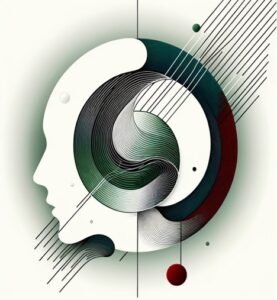Self-Improvement Sagas – Mental Health Awareness Month Series, Week 3
Healing from depression is not a single decision.
It is not a quick affirmation or a walk in the sunshine.
It is often a slow, uneven climb toward clarity—more endurance than epiphany.
For many, it feels like walking uphill through mud while others shout at them to “just think positive.”
That is why this week, we turn toward what actually helps.
There is no universal cure, but there is hope—hope rooted in research, clinical wisdom, and lived experience.
There are evidence-based interventions that do more than mask symptoms—they support lasting change.
And there are practices that respect both the neurobiology of suffering and the quiet complexity of the human soul.
Treatment Is Not One Size Fits All
Depression emerges from many causes: biological vulnerability, unresolved trauma, identity-based stress, early attachment injury, grief, burnout, chronic invalidation.
It makes sense, then, that treatment must be tailored, not templated.
Below, I outline several treatment pathways that I recommend—often in combination—depending on the client’s story and needs.
1. Psychotherapy: Rewiring the Mind with Relationship
In clinical practice, the therapeutic relationship is not merely a tool—it is the treatment.
Trust, attunement, and consistent presence become the soil where change can take root.
Cognitive Behavioral Therapy (CBT)
CBT is especially effective for mild to moderate depression and is often the first step in a treatment plan.
It focuses on identifying and restructuring maladaptive thoughts, and helps interrupt the depressive cognitive triad by:
-
Challenging automatic negative beliefs
-
Increasing behavioral activation (doing before feeling ready)
-
Rebuilding a sense of agency and mastery
Internal Family Systems (IFS)
Many clients with complex trauma or early emotional neglect find deep resonance in IFS.
Depression often forms as a “part” that protects against deeper pain—shame, fear, abandonment.
IFS allows us to access these internal systems without shame or blame. It is compassionate, non-pathologizing, and deeply transformative.
Eye Movement Desensitization and Reprocessing (EMDR)
For trauma-related depression, EMDR helps reprocess stuck memories that keep the nervous system in a frozen or collapsed state.
It is particularly effective when depression coexists with dissociation or somatic symptoms.
2. Medication: Lifting the Floor So Therapy Can Begin
Antidepressants are not magic, but they can be medicine.
They can lift the neurochemical weight just enough for someone to re-engage—with life, with relationships, with therapy.
SSRIs, SNRIs, and newer-generation agents help modulate serotonin, norepinephrine, and dopamine pathways.
Still, medication is not a guarantee. What works for one person may offer no relief—or cause side effects—in another.
3. Pharmacogenetic Testing: Personalizing the Medication Journey
With pharmacogenetic testing, clinicians can identify how an individual’s genes affect the metabolism of psychiatric medications.
It helps predict:
-
How quickly or slowly someone processes specific antidepressants
-
Risk of side effects or reduced efficacy
-
Guidance on dosage or medication class selection
Though access varies, pharmacogenetic testing marks a shift toward personalized care—aligned with trauma-informed and biologically respectful treatment.
It does not replace clinical judgment, but it informs it.
For clients who’ve tried multiple medications without success, this can be a turning point.
Medication does not negate inner work. It often makes the work possible.
4. The Brain Can Heal: Neuroplasticity and the Depressed Nervous System
One of the most hopeful findings in neuroscience is the brain’s capacity for change—neuroplasticity.
Depressive states are not fixed. The brain can relearn connection, curiosity, and even joy.
This is why we integrate more than talk therapy.
Somatic practices, trauma-informed yoga, breathwork, bilateral stimulation, and even cold exposure support nervous system regulation and increase vagal tone.
These aren’t “alternatives”—they are companions to psychotherapy.
5. Spirituality: Meaning-Making and the Inner Life
While not everyone uses the language of faith or religion, nearly everyone searches for meaning.
For some, that means prayer or spiritual connection. For others, it’s awe in nature, ritual, creativity, or simply the quiet belief that something larger holds us.
Depression often strips life of meaning. It can make everything feel flat, arbitrary, or untouchable.
Spiritual practices can help restore a sense of coherence—not by erasing the pain, but by making space for it within a larger story.
Spirituality in healing might look like:
-
Sitting in stillness or silence without needing to produce or perform
-
Reclaiming spiritual practices that once felt punitive or rigid
-
Connecting with faith communities, nature, or sacred texts
-
Exploring meaning through art, music, or mindful service
-
Allowing the mystery—uncertainty, doubt, and all
Trauma and depression can complicate one’s relationship with spirituality—especially if it was once used to shame or control.
Healing may involve redefining or rebuilding that connection, on one’s own terms.
Spirituality is not a substitute for treatment.
But for many, it deepens the work. It roots the struggle in something more enduring: meaning, belonging, love.
6. Lifestyle as Medicine: Sleep, Nutrition, Movement, Connection
It may seem too simple to matter, but the research says otherwise.
-
Sleep: Poor sleep predicts the onset and persistence of depression. Restoration begins at night.
-
Nutrition: The gut-brain axis is real. Omega-3s, complex carbs, and anti-inflammatory foods support mood regulation.
-
Movement: Exercise boosts dopamine, endorphins, and BDNF—proteins that promote brain growth and resilience.
-
Connection: Loneliness is a major risk factor for depression. Safe, non-judgmental relationships often do more than any one intervention.
These changes won’t cure depression alone—but they are part of the foundation for healing.
The Healing Process Is Not Linear
Recovery is not about returning to who you were before the depression.
Often, it’s about becoming someone more grounded, more self-aware, more compassionate with yourself.
In therapy, I remind clients:
The goal is not to never feel sad again.
The goal is to feel without being swallowed.
To live without losing yourself.
To grow roots even in uncertain soil.
Looking Ahead
If you’ve ever felt like healing shouldn’t take this long—this is your reminder: you are not doing it wrong.
Next week, we’ll close this series with reflections on recovery—what it means to live after depression, how to navigate relapse without shame, and how to carry forward a story of resilience.
For now, let this be your reminder:
Depression is not the end of the story.
It is a chapter to be met with respect, not rushed.
With presence, not pressure.



